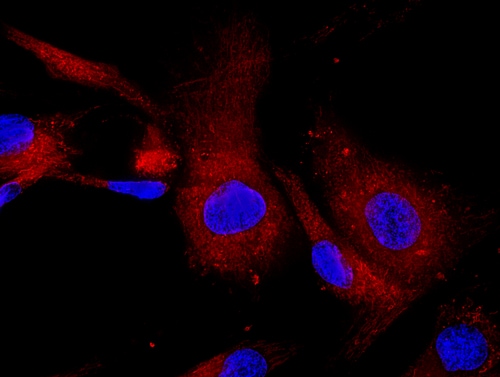 In a recent and celebrated coordinated publication of five scientific articles in Nature and Nature Communications, an international cohort of researchers characterized the molecular events involved in cellular reprogramming, whereby specialized cells become stem cells. In so doing, the team identified a novel stem cell type: fuzzy colony-forming, or F-class, cells. The scientific community has reason to believe that these unique stem cells could offer a new, economically prudent pathway for stem cell generation.1
In a recent and celebrated coordinated publication of five scientific articles in Nature and Nature Communications, an international cohort of researchers characterized the molecular events involved in cellular reprogramming, whereby specialized cells become stem cells. In so doing, the team identified a novel stem cell type: fuzzy colony-forming, or F-class, cells. The scientific community has reason to believe that these unique stem cells could offer a new, economically prudent pathway for stem cell generation.1
In one of these articles, Benevento et al. utilized a cluster of transcription factors—Oct4, Klf4, c-Myc and Sox2 (OKMS)—whose expression reprograms somatic cells to a state researchers term “induced pluripotent stem cells” (iPSCs).2 Because iPSCs resemble embryonic stem cells (ESCs) in terms of function and molecular structure, the development of this technology could have research and clinical applications. While previous studies indicate that this reprogramming process involves complex molecular events, including stepwise transitions through defined transcriptional states, no study has fully characterized the dynamic changes that occur at the proteome level. Understanding the underlying molecular mechanisms of reprogramming could allow researchers to manipulate the efficiency of the process.
Toward this end, the team used a secondary mouse embryonic fibroblast (2MEF) cell line generated using a doxycycline (dox)-inducible piggyBac transposon-based delivery system to model cell reprogramming toward F-class and ESC-like states. They applied strong cation-exchange chromatography and high-resolution tandem mass spectrometry, using an LTQ Orbitrap Velos hybrid ion trap-Orbitrap mass spectrometer (Thermo Scientific), to analyze isotope-labeled samples at 13 unique time points: precursor 2MEF, six intermediate high-dox time points, three intermediate low-dox time points, secondary and primary iPSCs, and Rosa26-rtTA transgenic ESCs.
Overall, the team identified 7,250 total proteins and quantified 4,454 of those. Just over half of the quantified proteins (2,452, or 55%) exhibited changes of more than two-fold in comparison with the precursor samples, indicating that dox-induced OKMS expression produces significant changes to the proteome.
The researchers made several temporal observations. After two days of dox-induced OKMS expression (1,500 ng ml-1), the proteome changed significantly from the precursor proteome. The samples then showed a distinct progression with dynamic changes at intermediate time points (2 to 11 hours) followed by a stable F-class state (16 to 18 hours). After an additional two weeks of high-dox treatment, these cells persisted at this stable state. On the other hand, when the team dropped the dox concentration 300-fold (5 ng ml-1) on the eighth day, the reprogrammed cells experienced changes that resulted in high correlation with the ESC-like proteome.
In terms of differential expression, the researchers identified upregulated proteins in both types of pluripotent cells, including those associated with nuclear processes, chromatin architecture and Nanog. They noted less abundant pluripotency markers in F-class cells as compared to both low-dox and ESC-like cells, likely linked to 5-methylcytosine and H3K27me3 inhibitory marks. The team also observed decreased levels for proteins associated with DNA methylation, telomere binding, and other transcriptional regulators in F-class cells.
Finally, the team looked at specific changes in the 2,452 differential proteins at each stage of reprogramming. They discovered that early protein changes included incitement of cellular machinery necessary for increased kinetics (cell cycle control, cellular proliferation, metabolism, energy production) and expression tuning (RNA processing, gene expression, nucleolar proteins). At this stage, fibroblasts also forfeit their cellular identity, downregulating mesenchymal markers and proteins associated with glycosylation, vesicle transport, extracellular matrix, and energy reserve metabolism. This “first wave” of proteome reprogramming also revealed strong enrichment for c-Myc, Kdm5b and Jarid2a target genes.
The intermediate phases of resetting showed increased epithelial proteins, retinoic acid signaling, and adhesion molecules specific to ESC. For F-class cells, the later changes included coordinated loss of epithelial and adhesion proteins, when compared to low-dox and ESC-like cells. The predominantly expressed proteins in these F-class cells were linked with metabolism and cellular proliferation and were largely regulated by the c-Myc network. Here the researchers also noted early and transient upregulation of retinoic acid and signaling proteins. The team observed strong enrichment for proteins associated with DNA replication, transcription regulation, and chromatin modulation in secondary iPSC samples.
Overall, Benevento et al. offer the data generated in this study, along with four sister publications, as a unique resource for understanding the molecular mechanisms of cell reprogramming. Together, these resources identify two separate reprogramming routes, including the route toward F-class formation. Ultimately, the total finding could make the production of stem cells faster, simpler and less expensive, positively impacting drug screening, disease modeling and disease treatment applications.1
References
1. McEwen Centre for Regenerative Medicine. (2014, December 11) “Cracking the code of cellular reprogramming.”
2. Benevento, M., et al. (2014, December) “Proteome adaptation in cell reprogramming proceeds via distinct transcriptional networks,” Nature Communications, 5 (p. 5613), doi: 10.1038/ncomms6613.
Post Author: Melissa J. Mayer. Melissa is a freelance writer who specializes in science journalism. She possesses passion for and experience in the fields of proteomics, cellular/molecular biology, microbiology, biochemistry, and immunology. Melissa is also bilingual (Spanish) and holds a teaching certificate with a biology endorsement.
Leave a Reply